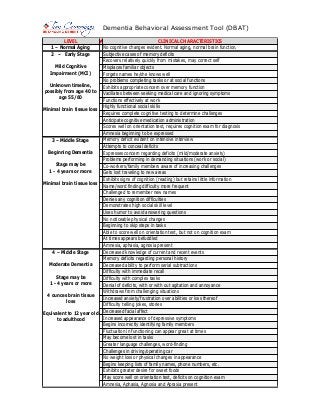
ATX11 - "Ethics in End of Life and Dementia Case Management" - DBAT Assessment Tool
- 1. Dementia Behavioral Assessment Tool (DBAT) LEVEL 1 – Normal Aging 2 – Early Stage Mild Cognitive Impairment (MCI) Unknown timeline, possibly from age 40 to age 55/60 Minimal brain tissue loss 3 – Middle Stage Beginning Dementia Stage may be 1 - 4 years or more Minimal brain tissue loss 4 – Middle Stage Moderate Dementia Stage may be 1 - 4 years or more 4 ounces brain tissue loss Equivalent to 12 year old to adulthood ✔ CLINICAL CHARACTERISTICS No cognitive changes evident. Normal aging, normal brain function. Subjective cases of memory deficits Recovers relatively quickly from mistakes, may correct self Misplaces familiar objects Forgets names he/she knows well No problems completing tasks or at social functions Exhibits appropriate concern over memory function Vacillates between seeking medical care and ignoring symptoms Functions effectively at work Highly functional social skills Requires complete cognitive testing to determine challenges Anticipate cognitive medication administration Scores well on orientation test, requires cognition exam for diagnosis Amnesia beginning to be expressed Memory deficit evident on intensive interview Attempts to conceal deficits Expresses concern regarding deficits (mild/moderate anxiety) Problems performing in demanding situations (work or social) Co-workers/family members aware of increasing challenges Gets lost traveling to new areas Exhibits signs of cognition (reading) but retains little information Name/word finding difficulty more frequent Challenged to remember new names Denies any cognition difficulties Demonstrates high social skill level Uses humor to avoid answering questions No noticeable physical changes Beginning to skip steps in tasks Able to score well on orientation test, but not on cognition exam At times appears befuddled Amnesia, aphasia, agnosia present Decreased knowledge of current and recent events Memory deficits regarding personal history Decreased ability to perform serial subtractions Difficulty with immediate recall Difficulty with complex tasks Denial of deficits, with or with out agitation and annoyance Withdraws from challenging situations Increased anxiety/frustration over abilities or loss thereof Difficulty telling jokes, stories Decreased facial affect Increased appearance of depressive symptoms Begins incorrectly identifying family members Fluctuation in functioning can appear great at times May become lost in tasks Greater language challenges, word-finding Challenges in driving/operating car No weight loss or physical changes in appearance Begins keeping lists of family names, phone numbers, etc. Exhibits greater desire for sweet foods May score well on orientation test, deficits on cognition exam Amnesia, Aphasia, Agnosia and Apraxia present
- 2. Dementia Behavioral Assessment Tool (DBAT) LEVEL 5 – Late Stage Moderately Severe Dementia All Dressed Up, Ready To Go Stage may be 1-3 Years ½ to 1 pound brain tissue loss Equivalent to 8 – 12 year old *Equivalent to 4– 8 year old 6 – Late Stage Severe Dementia In My Own Little World Stage may be 1 - 3 Years 1 to 1½ pounds of brain tissue loss Equivalent to 2 – 4 year old 7 – Late Stage Very Severe Dementia Bedbound Total Care Required Stage may be 1 to 2 years 1½ to 2 pounds brain tissue loss Equivalent to Infants – 2 year old ✔ CLINICAL CHARACTERISTICS Disorientation to time (date, day of week, season, etc.) or place Immediate memory relatively intact Needs assistance choosing clothing, layers clothing May crave sweets over other foods Denies need for assistance with ADLs/IADLs Hunting and Gathering Stage Urinary Incontinence begins –monthly to weekly to daily Wears clothing appropriately (hearing aid, glasses, carries purse) Feeds self (may need meal set-up) Sleep disturbances Can score well on an orientation test Wanders looking for a way out (purposeful wandering/ Sun-downing) Follows simple instructions for ADLs, verbal cues needed for tasks Unexplained tearfulness or extreme laughter Catastrophic reactions Some resistance to care giving *May begin chronic Urinary Tract Infections *Appears severely depressed *Increased loss of facial affect *Coordinated movement/function beginning to be affected *Begins to be lost in current time *Difficulty recognizing self in a mirror *Challenged to recall family members *Accuses family members, caregivers of theft, infidelity, lying *Automatic “yes/no” speech functions, but without understanding *May begin using curse words as temporal lobes become damaged *Changes in visual perception increasing *Difficulty interpreting background noise *Challenged to perform rehab for injuries, may appear stubborn *Cannot give accurate information *Caregivers may confuse behavior for purposeful action – lying, etc. *Physical appearance beginning to be affected *Pilling or rubbing motions common, may enjoy folding items *Amnesia, Aphasia, Agnosia and Apraxia evident to outsiders Unable to recall most recent events Repetitiveness in motion or speech or memory May be in constant motion, wanders/walks for hours Removes/won’t wear clothing appropriately (glasses, hearing aid) Refuses to change clothing Feeds self with set-up; cues; assist Bowel incontinence begins Sleep disturbances, may increase sleep, may require little sleep Catastrophic reactions, great resistance to care giving, bathing Purposeless wandering/Sun-downing (wandering without an agenda) Cannot complete a two-stage command Apraxia advanced, gait altered (small shuffling steps) Aphasia increased, great language loss Weight loss beginning Difficult to engage with caregiver, challenged to initiate conversation Disregards eyeglasses, dentures, hearing aids (agnosia) Disheveled appearance May begin sleeping for longer periods of time Difficult to perform rehab for injuries Almost total loss of facial affect May suddenly use complete sentence, then only words or sounds Frequently no speech at all – mostly grunting Cannot feed self --- Chipmonking, high choking risk Unable to sit up independently, unable to hold head up Loss of basic psychomotor skills (unable to walk w/o assistance) Hyper oral (may put everything in mouth) Requires total care, Displays great muscular flexation Extreme risk for skin breakdown Spends majority of day asleep or semi-alert Loss of ability to smile – indicative death is near
